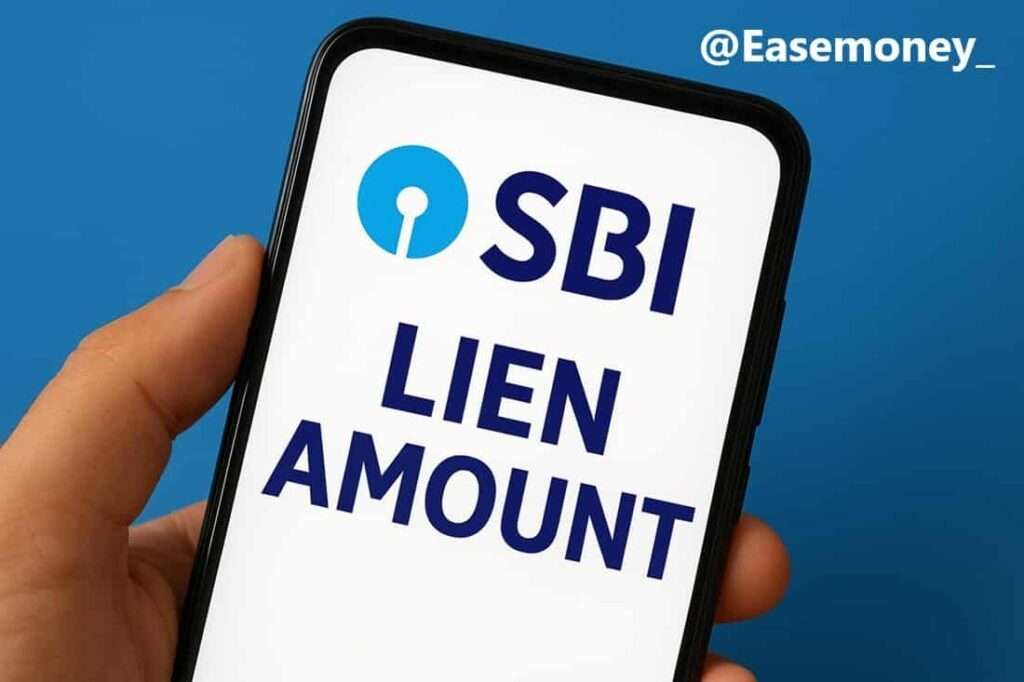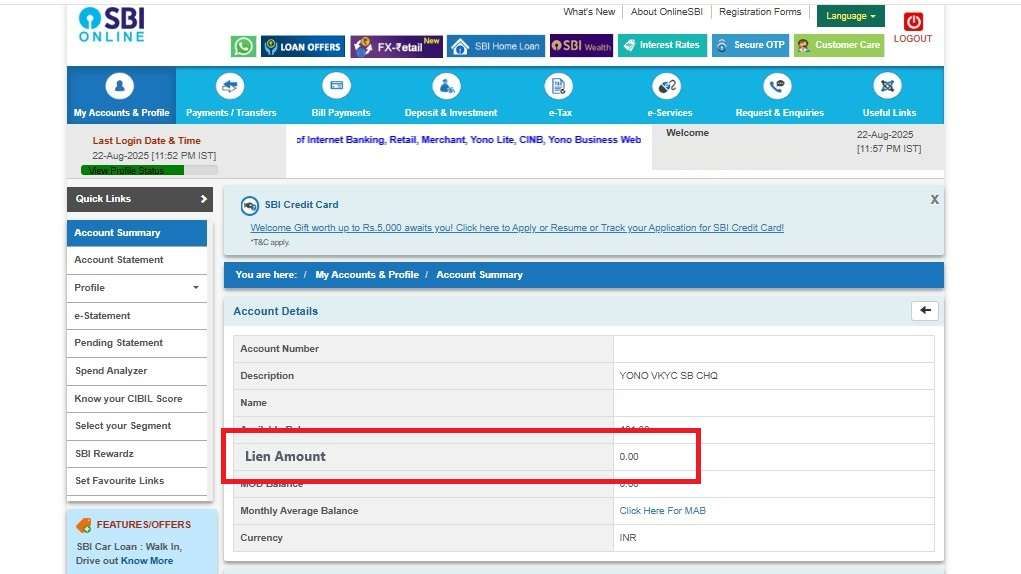A lien amount on your SBI account means a portion or the full amount of your account balance is kept on hold by the bank. While your passbook or YONO app may show a certain balance, however, it is temporarily blocked, which cannot be withdrawn or used until the reason behind the lien balance is cleared.

It is usually done to secure any pending dues, unpaid hidden charges, or as a hold for other transactions.
Let me tell you in a real example, if your savings account tells you the total available amount is ₹50,000, but ₹10,000 is under a lien, your actual available balance is only ₹40,000.
A lien is different from a permanent deduction. The money still belongs to you, but it is locked until the bank or authority releases it and settles it.
What Situations Create a Lien in SBI
Lien appears in many day-to-day cases. Some of the most common include:
- Cheque bounce: If your provided cheque bounces due to a low amount, SBI may place a lien until settlement.
- Loan or EMI overdue: The most common is that if you miss an EMI, it triggers a lien for the overdue portion.
- SBI credit card bills: If the minimum due is not cleared, a lien can be marked on your linked savings account.
- Account maintenance charges: Annual fees or a penalty for non-maintenance of the balance may result in a hold on the available balance.
- IPO or ASBA applications: Money gets blocked as a lien until allotment is finalised.
- Court orders or government recovery: Legal authorities can instruct SBI to freeze or lien a certain amount.
- Fraud monitoring: if any cybercrime fraud happens where your account is linked by mistake or any suspicious transaction is noticed, SBI can temporarily mark a lien to prevent misuse.
- Online gaming withdrawals: In 2025, many accounts receiving gaming or betting withdrawals face a lien under compliance checks.
- Income Tax and GST orders: Sometimes, it may trigger due to Income tax attachments, GST dues, or legal cases can cause lien freezes.
Where to Check Lien Amount in SBI Online
1. YONO SBI App
The most reliable and easiest place to check your lien details with proper explanation is your SBI account statement or the YONO app.

- First of all, open your YONO SBI app (update to the latest version for quick access)
- Now, log in by entering your 6-digit mpin or your fingerprint.
- If you are using first time, create a username and password using your debit card details. Also, set a 6-digit mpin.
- On the dashboard, tap on accounts in the header.
- If you have multiple accounts, select the account number.
- Now, under the overview section, the screen will show your available balance and whether any lien or hold amount exists.
- If the lien amount is visible, check the last few transactions for pending charges.
2. SBI Online (Netbanking)

- Simply, open your Google Chrome and search for SBI online, the official portal.
- Tap on the Safe login button, and enter your username, password, and captcha.
- You have to provide a 6-digit OTP to verify your digital account.
- Now, tap on My Accounts and Profile and select account summary.
- Check any lien, uncleared, or hold amount information.
Note: If you cannot identify the reason, please contact SBI customer care directly or visit your home branch for clarification and removal.
Which Types of Lien Exist in the State Bank of India
There are two broad categories:
- Bank recovery – Applied when SBI needs money from you. This includes cheque bounce, penalty charges, annual fees, EMI dues, loan arrears, and account maintenance costs. Funds are kept on hold until the bank recovers or you pay the full hold amount.
- FD or credit card – Applied when you pledge a fixed deposit for a loan, or when SBI secures dues on your credit card. In these cases, the lien acts as collateral rather than a penalty.
When SBI Releases Lien Amount Automatically
A lien is not always permanent. It gets lifted in several cases:
- Overdue EMI or credit card bill is paid – once you clear any remaining overdue amount, the lien is removed, often within 24–72 hours. In most cases, it settles down within 24 hours.
- IPO/ASBA application refund – once allotment is over, blocked funds are released.
- Charges or penalties deducted – lien disappears once the bank recovers its dues.
- FD release – after closing a pledged loan or overdraft, SBI cancels the lien on the fixed deposit.
- Fraud check resolved – if the flagged transaction is verified, the freeze or lien is removed.
As per the SBI YONO AI Chatbot, the official statement says it takes upto 7 working days after requesting to settle any hold amount. Here are a few cases and a timing period –
- IPO refund: Within 7–10 working days
- Technical holds: 24–48 hours
- FD loan repayment: Once the overdraft is closed
- Service charges: Immediately after deduction from available funds
How can you remove any lien amount with SBI instantly
First of all, you have to verify the real reason why it happened. Here are common scenarios and how they will be settled –
- Pending dues: most common but important, all you have to do, clear any overdue bills, including credit card, personal loan, or any late payment fees. Once cleared, the lien is lifted automatically.
- Cheque bounce or penalties: If you unsettle the cheque amount or penalties remaining, please pay first to settle it within the next 1 or 2 working days.
- IPO application: If shares are not allotted, the lien is removed after the refund cycle. You can cancel the request, but it still takes 3/4 working days to approve.
- FD or secured credit card: Close the FD loan or repay credit card dues to release the hold.
- Fraud suspicion: Submit proof of transaction legitimacy or wait for the bank’s investigation to complete.
- Court/government: Follow the legal process; only after compliance or clearance will the bank release funds.
- Gaming/Betting Withdrawals: If flagged as suspicious, you have to visit a branch and submit proof with a winnings tax receipt to settle your request. Otherwise, the account may remain frozen or blocked.
Steps to Contact SBI Customer Care for Lien Issues
- You have to make a call to the SBI helpline 1800 1234 or 1800 2100 from your account-linked number.
- Select the options from the IVR account services.
- Press the required number keys to connect with a bank representative.
- Provide your full name and the last 4 digits of your account number to find details.
- Now ask clearly – “Why is the lien amount showing in my account?” and give the timing when it happened.
- The representative checks backend systems and informs of the exact cause.
- Based on the issue, they guide you on payment, dispute resolution, or documentation.
- After settlement, they also provide you with the timing when it will remove this lien amount.
Important Note: if any gaming fraud or cybercrime issue is causing you a lien balance, you have to visit your home branch to solve it.
What Happens If You Ignore a Lien Amount
- For unpaid dues: Penalties increase, and the bank may auto-debit your account.
- FD Related: The bank can liquidate the FD or adjust against the credit card limit.
- For fraud or gaming transactions: In 2025, many SBI accounts linked with suspicious gaming withdrawals or cybercrime have been frozen. If ignored, the lien may convert into a complete freeze, blocking all deposits and withdrawals.
- For legal orders: Ignoring an Income tax, a government-owned department, or a court lien can lead to the freeze indefinitely and create compliance issues.
Users FAQs
Can the lien amount in SBI affect UPI or debit card payments?
Yes, in most cases, if the lien reduces the available balance, UPI transfers or debit card swipes may fail even though your total account balance looks sufficient.
Can I get an SMS alert when the lien amount is placed in SBI?
Not really, SBI does not provide any direct notification, but a customer notice while using the YONO app or doing any withdrawal or UPI Payments.
Join 60,000 readers who get exclusive credit and banking deals, RBI updates, and investment insights from Easemoney.